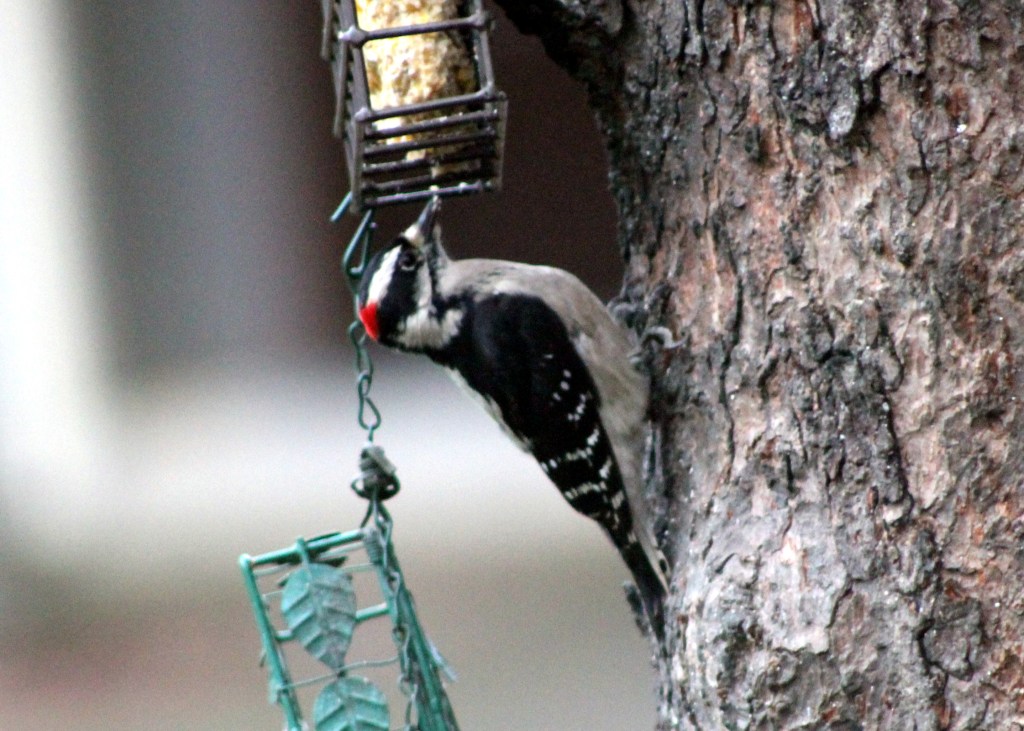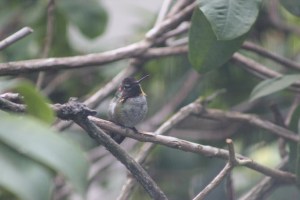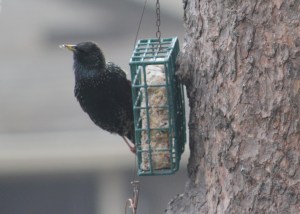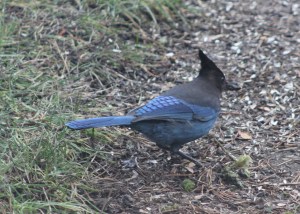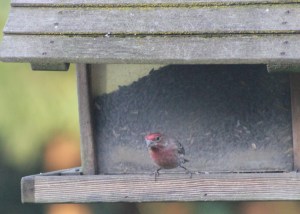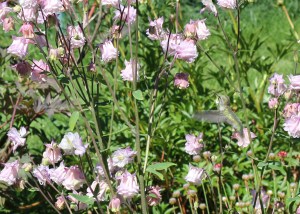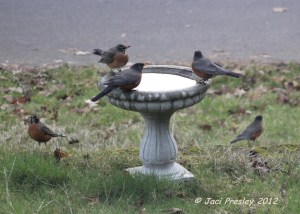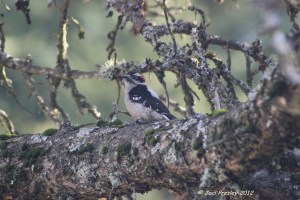A number of years ago, I bought this fun wrought iron plant stand at a yard sale. I was in love with it and intended to use it for a bird bath. The downside to the purchase was the ugly vintage pot that came with it (I couldn’t buy the plant stand without the pot). The upside was that I stopped at another yard sale where I purchased my little secretary desk, and the woman who helped me load the desk into the back of my car fell in love with the pot. I donated the pot to her for helping me load the desk, and we both gopt what we wanted.
Later, I purchased a deep bowl at a thrift store, and – ta da! – had a bird bath. A bird bath that attracted bees and wasps to their deaths. Ugh. I tried a wire across the bath (photo with the dragon fly), but the birds and the dogs managed to knock it off all the time, and I still ended up with drowned bees, flies, and wasps. Last year, I made a little safety raft out of matchsticks, in the hopes the insects would crawl up onto it and thus save themselves. . Insects don’t understand the concept, and I continued to have dead ones in the bowl.
The problem is the slick sides of the bowl. The porcelain that makes it so desirable for human use is deadly for insects.

I don’t have that problem in this birdbath, poured of rough concrete. If insects land in it, they can get back out of it because they can grip the concrete. (Don’t ask about the crows that dump questionable food items into it, in an effort to soften up the Kentucky Fried Chicken leg bones so they can eat the bone marrow. Or worse. Crows are like raccoons, with a desperate need to “wash” their food first, and to the detriment of any other bird needing a bath or drink).
I digress.
This year, I saw a very neat idea for creating a bee watering station, and it occurred to me that instead of a second bird bath, what I really needed was a bee watering station where the bees, wasps, and flies wouldn’t drown. Now, bees and wasps play a very important role in our eco-system, and most wasps are not akin to the common (and hot-headed) yellow jacket or bald-faced hornet. In fact, most hornets are calmer than most yellow-jackets, and only become agitated if they feel attacked (like when you step on their nest in the woods). I will go out of my way to deal with a yellow-jacket nest, but I tend to leave all other wasps, hornets, and bees alone.
We are in a bee crisis. Non-native honeybees are dying off, the native bees are threatened, and the rusty-patched bumblebee was just added to the Endangered Species Act. My yard is a veritable haven for native bees, from iridescent green sweat bees to tiny black bees to Mason bees to dozens of bumblebees, all the way to honeybees, mud-dauber wasps, and how-many-other wasps and bees I-don’t-know. Protecting them is as important to me as providing habitat for the birds that frequent our yard.
Have I ever mentioned how dead this yard was when we moved in here, the summer of 2002? Not an insect buzzed and not a bird flitted through. We began organic (for the most part) gardening, feeding the birds, and added my first birdbaths. Now, the yard is a haven for buzzing and singing.
The pictures on the Web that I found showed shallow bowls filled with clear marbles. I searched high and low at the thrift store until I found a shallow bowl that I liked (not plain white!). I already had a vase full of glass rounds and polished agates, so filling the bowl was a cinch. The frog was a bonus. When I switched out he deeper bowl, I found at least half a dozen drowned mason bees in it (already!!). My hope is to never find a drowned bee again. And I like the addition of color to my garden.
Speaking of which…
I found this funky bowl-thing-fountain at the thrift store. Somebody actually paid that $49.99 price for it. It’s freaking UGLY. I paid $6.99 to save it. I mean, a little acrylic paint, a sealer, and a couple of my assorted ceramic frogs…
And, yes, water. It’s not exactly utilitarian as a bird bath, but the bugs and birds can get a drink, and I get to enjoy the funkiness of it.
I included slugs in the title of this post, and I really intended to have more photos for that portion of the blog, but it didn’t happen. Here’s the deal: we have a slug problem. I live in the Pacific Northwest, in the rain-forest side of the state. When I was a girl, my family would come from Nevada to visit here, and my sister and I took perverse pleasure in pouring salt on slugs to watch them die. It’s awful, and really not humane. I’m older now, and I like to just cut to the chase.
I hate slugs. I loathe slugs. Non-native snails are right behind slugs on the loathe list, and neither one is loathed because of what it is, but because of the damage it does to my plants. Slugs are a special kind of pestilence in the garden, devouring irises almost as soon as they provide fresh greenery. I have tried everything. Beer in shallow dishes just provides you with a dish full of drowned slugs that you have to dispose of. Disgusting. And inefficient, because you have to 1) change the beer daily, 2) buy beer you won’t drink (which would be any IPA in my case), and 3) expensive because beer isn’t cheap.
I’ve carried a bucket of bleach water around with me and tossed slugs into that. It’s as disgusting as slugs drowned in beer. I have (and still do) practice slug tossing (ala the book “Slug Tossing” by Meg Descamp, which I read many years after I decided the only real solution to slugs is poison. But Meg is hysterical, and I love her book). But, yes, poison. Corey’s Slug and Snail Death.
You don’t want your pets or the birds to get into this stuff. So here is how I conquered that problem creatively. Use decorative ceramic planters.

See that pot underneath the frog fairy planter? There’s a supply of Corey’s under there with plenty of access for the pestilence to get to it. I set up these “feeding stations” around my garden, even where the dogs frequent, and always close to the plants the slugs like best. Dogs can’t smell it, birds can’t get to it, and slugs crawl in and die. They die, dehydrate, and compost and I never have to deal with their slimy carcasses, and nobody innocent gets poisoned. It’s one of the very few instances where I bow to the use of poisons. It’s not 100% effective (or, rather, slugs are more prolific than worms or bunnies, so it only catches the ones I want caught, and the rest go on procreating under the deck or whereever they hide in the daytime).
I wonder how I came to have so many ceramic frogs??

This is my dad. He promised me that he would come back as this ceramic frog. I brought him home and, suddenly, I had a plethora of little ceramic frogs to put in my garden. Coincidence? Maybe. But I wouldn’t put it past Dad.
Now – a total digression. I was going to take a photo of the chickadee watering station (aka ant moat) over the hummingbird feeder. EXCEPT that the female Anna’s was NOT moving out of the feeder. These are taken with the 50mm lens, from about four feet. Yes, she let me get that close.
That ant moat above the hummer feeder is where the chickadees, juncos, and Townsend’s warbler get water. They disdain the bigger birdbath for the ant moat.
(And, if you are wondering – yes, the ant moat works to keep ants out of the hummer feeder – so long as you keep the moat filled with water.)
I should write a book on gardening in the Pacific Northwest. Hmmmm.
Read Full Post »


